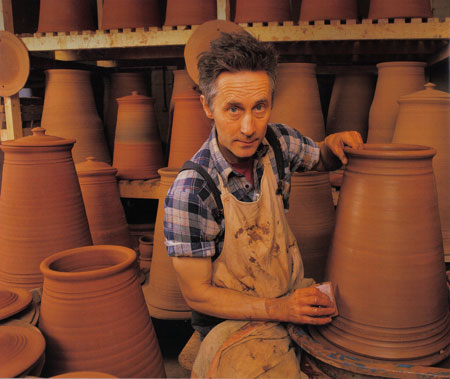
I am feeling confident that my rhubarb plants have finally taken to my garden and so, finally, I can resonably justify trying to force rhubarb. Forced rhubarb provies an earlier, sweeter and more tender stalk. This seems like a vague reason to give it a try, and then there are the implements. In order to do it you have to keep the plants in the dark, giving me an ever better reason to satisfying my longtime lust for terracotta rhubarb forcers. Plus, to harvest it ‘traditionally’ you must go into the garden at night by candlelight….which is nothing short of utterly romantic.
A year ago(Feb 2010), Yorkshire Forced Rhubarb was awarded Protected Designation of Origin (PDO) status by the European Commission’s Protected Food Name scheme. (I’m a big fan of the European regional designations and their ability to celebrate local agriculture.) The “Rhubarb Triangle” is a 9-square-mile triangle in West Yorkshire, England located between Wakefield, Morley and Rothwell and it is famous for producing early forced rhubarb.
I’m fascinated to learn that pre-WWII, when rhubarb was immensely popular, rhubarb fields were fertilised with large quantities of horse manure and ‘night soil‘. Night soil? Yeah, I had to look that one up too….it’s a euphemism for human excrement collected at night from cesspools, privies, etc. and used as a fertilizer. The collectors of ‘night soil’, were called gong farmers. According to wikipedia: “Gong farmers were only allowed to work at night and the waste they collected had to be taken outside the city or town boundaries. They later became known as “night soil men” or “nightmen” and in the Manchester area they were also known as the Midnight Mechanic.” Yep. Uh-huh…not sure what else to say about that…..

But rounding back to the Rhubarb forcers, there are some nice ones offered on ebay that ship world wide but John Huggins makes beautiful hand crafted versions (but I am not sure his shipping policy).
AND….he also holds classes (why another cool class….my, my, I must admit, my lust for learning is seems to find no end). The class is called ‘The Big Pot Class‘ and runs early in August annually. The goal, to teach basic potters how to make even bigger, taller, better pots. Participants can take home up to 10 pots that they make over the week of the class — which at 325(GBP) + materials seems like a bargain.
I love these pots and saw lots of them at Heligan in England. Guy Wolff makes a version also. I don’t have one yet but would love to make one….sounds like fun.
With hedge laying classes and rhubarb pots you need a learning holiday in England!
I have a Victorian rhubarb forcer in the shape of a tree trunk. Now that you have reminded me I shall use it this year. The shoots are just beginning to appear. I have lost the lid though, an upturned bucket will have to substitute.
I know helen — and I so miss england!
would love to take that class!